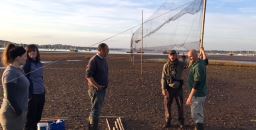Mist-netting - Exminster Marshes - Thursday 27 February 2020
High Tide 3.60m @ 20:59, Sunset 17:51, Rendezvous 17:00
After a successful catch of waders in early February on a field adjacent to RSPB Exminster Marshes Reserve, a second attempt on the same field and on RSPB Exminster Marshes Reserve was eagerly anticipated.
With a new moon on the 23 February and high tides several hours after sunset, the entire week of the 24-28 February appeared suitable. However, stormy weather conditions predominated, restricting our options. Winds were forecast to relent for a short while on Thursday evening, so a session was planned and a team assembled. In the event conditons were near perfect for mist-netting. The objective of the session was to target Curlew and continue colour-ringing of this species on the Exe, to add to the 7 birds already colour-ringed.
Due to the later sunset time of 17:51 and larger team as well a new familiarity with the site, the team assembled 2 hours later than last trip, this time meeting at 17:00. On arrival 21 curlews were located feeding on field 13 (left field, non-RSPB), before these lifted over onto the marsh. A near identical net set to early February was put up, with 2-shelf nets set on 2 large freshwater pools. With and increased team of 9 ringers and 5 helpers we had the ability to also set nets in field 14 (right field, RSPB). This field comprised of a series of fantastic new habitat recently created by the RSPB, with engineered scrapes and ridges running between pools. Two lines of full height wader nets were set around these scrapes.
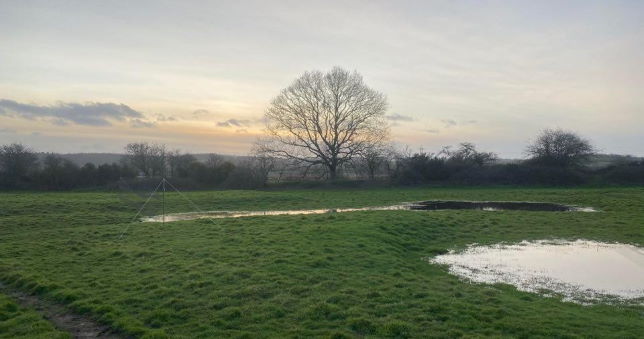 Nets set in field 13, Exminster Marshes
Nets set in field 13, Exminster Marshes
With dusk pretty much over by the time nets were set, the sounds-lures were put out and the first net round conducted. This produced a surprise of 7 Curlew coming in to roost early, which were quickly ringed, colour-ringed and released. Soon after this we had a second round producing a further 2 Curlew one from each field and 8 godwit. From this point on from each net round up to and beyond high tide we ringed small numbers of waders plus two Wigeon and a Mallard.
All 9 curlew were colour ringed taking the group total to 16 marked birds and the late addition dunlins added two more to the colour-ring study. Curlew were all aged as adult and the rest of the waders made up a mix of both first winter and adult birds in a 50/50 split. The mallard was an adult female and both wigeon adult males. No Curlew were fitted with GPS-GSM tags during this session as these will be saved for tagging of more birds in subsequent winters.
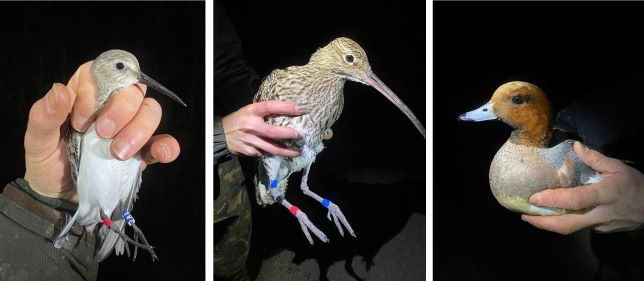 Adult Dunlin, adult female Curlew and adult male Wigeon
Adult Dunlin, adult female Curlew and adult male Wigeon
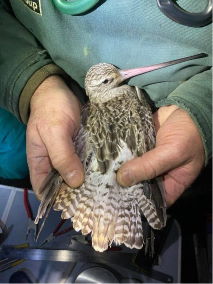 Juvenile Bar-tailed GodwitThis session produced excellent results and based on the colour-ring recoveries by our committed resighters so far will contribute excellent resighting data for future survival analyses. With a large team and a large range of expertise this session gave us the opportunity to undertake training of new DCWRG members and involve RSPB staff in the ringing process. The RSPB team’s enthusiasm and passion for waders matched our own, with discussions about how the data colour ringing and tagging can improve our understanding wader special ecology, survival and how waders use the wetlands and marsh around the Exe Estuary. Thanks, must go to the RSPB and David King for allowing us permission of operate on their land, for supporting our projects and the expansion of our knowledge of waders in the Exe Estuary.
Juvenile Bar-tailed GodwitThis session produced excellent results and based on the colour-ring recoveries by our committed resighters so far will contribute excellent resighting data for future survival analyses. With a large team and a large range of expertise this session gave us the opportunity to undertake training of new DCWRG members and involve RSPB staff in the ringing process. The RSPB team’s enthusiasm and passion for waders matched our own, with discussions about how the data colour ringing and tagging can improve our understanding wader special ecology, survival and how waders use the wetlands and marsh around the Exe Estuary. Thanks, must go to the RSPB and David King for allowing us permission of operate on their land, for supporting our projects and the expansion of our knowledge of waders in the Exe Estuary.
| Species | Ringed | Retraps | Controls | Colour ringed | GPS tagged |
|---|---|---|---|---|---|
| Curlew | 9 | 0 | 0 | 9 | 0 |
| Bar-tailed Godwit | 15 | 0 | 0 | 0 | 0 |
| Black-tailed Godwit | 1 | 0 | 0 | 0 | 0 |
| Redshank | 3 | 0 | 0 | 0 | 0 |
| Dunlin | 2 | 0 | 0 | 2 | 0 |
Mist netting - Exminster Marshes - Saturday 1 February 2020
High Tide 2.90m @ 23:06, Sunset 17:05
In late December, a potential option for catching Curlew on the RSPB Exminster Marshes Reserve and surrounding wet fields was identified by WeBS counter James Diamond who covers that segment of the shore (thanks James!). Curlew and a mix of other wader had been coming up on to these fields at high tide, both during the day and at night. After work by Ryan Burrell and Tim Frayling in January, permission was secured for targeted mist-netting on RSPB Exminster Marshes and nearby fields from a private landowner to support our colour-ringing and GPS-tracking studies.
The objective of session on these holdings was to target Curlew to commence our fitting of the 10 GPS-GSM tags we secured through the Natural England grant. After inspection of moon phase and tides, recces by local DCWRG members and after discussion with other successful Curlew mist-netters, Ryan concluded that our best chance would be the end of February but that also an attempt could be made at the beginning of Feburary. Though the tides and moon phase and his availability to fit the GPS tags ruled out any catching taking place then. Due to an opening in Ryan’s schedule, the decision was made on the morning of Saturday 1 February to conduct a pilot session the following evening despite the unsuitable conditions of a bright moon and low high tide meaning catching was highly unlikely.
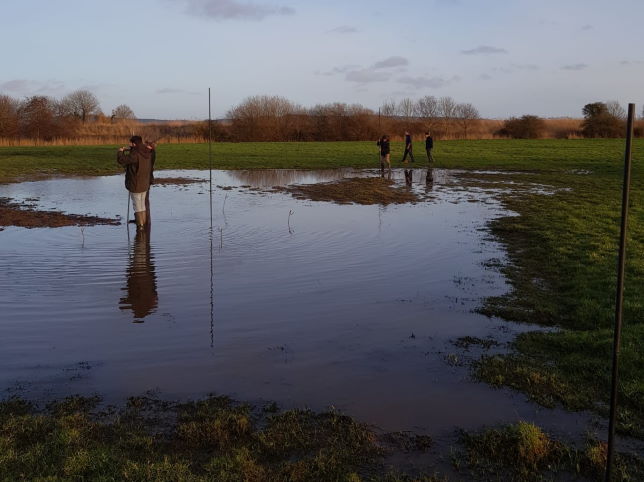 Setting nets at Exminster Marshes 1 Feb 2020
Setting nets at Exminster Marshes 1 Feb 2020
An hour or so after dusk, 2 Lapwing and a Woodcock were caught. This was a surprise, as the moon was still bright, and both these species are known to be good at identifying and avoiding nets. Several rounds later, in advance of high tide, a single Grey Plover was caught. As with the Lapwing and Woodcock before it, this was a very welcome first for the group, especially as we have a colour-ringing scheme registered for this species. Half an hour before high tide, when the team had all but given up hope that the Curlew were going to be pushed from the estuary by the tide, a flock of ~20 Curlew circled above the field and landed in the freshwater pools, 6 were caught and promptly extracted, during which time a further two Curlew and a single Grey Plover were caught. Five GPS-GSM tags were deployed on Curlew in total (3 Females and 2 Males), with the remainder held for winter 2020/21. These will record a fix every hour for potentially the next 2-3 years tags but unlike those which we have used on the Oystercatcher’s at Dawlish, transmit their data via the mobile phone network, approximately every 21 days.
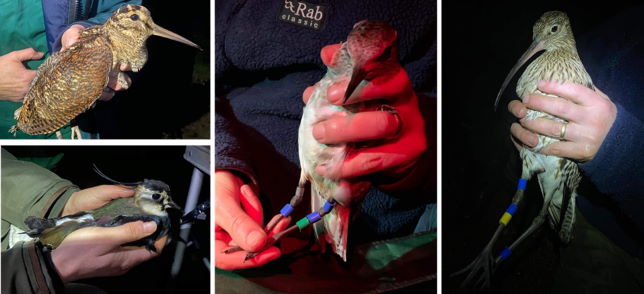 Birds ringed at Exminster Marshes 1 Feb 2020
Birds ringed at Exminster Marshes 1 Feb 2020
This session was a really exciting development for the group and our projects, with a further session planned in late Feburary to fit further colour-marks. Thanks must go to the RSPB and David King for allowing us permission to operate on their land and for supporting the project to allow us to expand our knowledge of waders in the Exe Estuary.
| Species | Ringed | Retraps | Controls | Colour ringed | GPS tagged |
|---|---|---|---|---|---|
| Curlew | 8 | 0 | 0 | 8 | 5 |
| Grey Plover | 2 | 0 | 0 | 2 | 0 |
| Lapwing | 2 | 0 | 0 | 0 | 0 |
| Woodcock | 1 | 0 | 0 | 0 | 0 |
Mist netting - Dawlish Warren - Tuesday 17 December 2019
High Tide 3.40m @ 22:19, Sunset 16:09
On 17th December 2019 a team of 7 – Ryan Burrell, Chris Dee, Tamsin Quinn, Thomas Weston, Alys Perry, Robbie Phillips and Tim Frayling met at Dawlish in the afternoon to set three sets of mist nets near the island, the re-charge area and Finger Point. Once we had set the nets, half the team went to collect the chip order. During this time, the thermal scope came in handy identifying a bird in the net early – a Dunlin, which was colour ringed (with the code ‘AJ’ - see re-sighting history here). Although we were initially hopeful of catching many more, a fog descended which seemed to result in the birds being less willing to move around. We ended the evening with 6 new birds – 1 Dunlin, 3 Redshank and 2 Oystercatcher. Unfortunately, although Ryan was ready to deploy GPS tags if they were juveniles, typically both Oystercatchers were adults.
| Species | Ringed | Retraps | Controls | Colour ringed | GPS tagged |
|---|---|---|---|---|---|
| Oystercatcher | 2 | 0 | 0 | 2 | 0 |
| Dunlin | 1 | 0 | 0 | 1 | 0 |
| Redshank | 3 | 0 | 0 | 0 | 0 |
Mist netting - Dawlish Warren - Saturday 16 November 2019
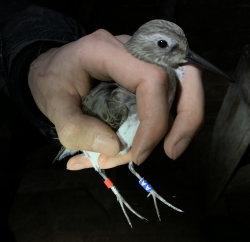 Dunlin colour-ringed on 16 Nov 2019 © A J Bellamy
Dunlin colour-ringed on 16 Nov 2019 © A J Bellamy
High Tide 3.60m @ 20:53, Sunset 16:10, Rendezvous 16:00
The 16th November brought another nocturnal suitable height spring tide and with it our next mist-netting session. Conditions looked favourable with light cloud and no wind, so the team were hopeful for a useful catch despite the bright moon. The target for the mist-netting sessions of juvenile Oystercatchers remained, with 8 GPS-UHF tags still to deploy for winter 2019/20.
The team assembled at 1600, met by session leader Nik Ward who was suffering with the most non-existent streaming cold imaginable (get well soon Nik). Well 1600ish…all except Ryan Burrell and Thomas Weston who were 30 minutes late, though they were let them off as they had driven straight to Dawlish from the Solent via the DCWRG kit store, as they had been cannon-netting at dawn for a tracking study with Farlington Ringing Group and GWCT.
| Species | Ringed | Retraps | Controls | Colour ringed | GPS tagged |
|---|---|---|---|---|---|
| Dunlin | 4 | 0 | 0 | 4 | 0 |
| Knot | 1 | 0 | 0 | 0 | 0 |
| Greenshank | 1 | 0 | 0 | 0 | 0 |
Mist-netting Background
The use of mist-nets on high tides during the hours of darkness is less selective in which species are caught, but this technique provides us with additional opportunities to catch and ring waders in the region. A mist-net catch can usually be managed with a smaller team and without the need for a specialist cannon net license holder or the preparatory work needed to reconnaisace precise roost sites and set cannon nets in advance of the planned catch tide.
Our focus on the Exe estuary is the wintering Oystercatcher population and this species is our primary target for mist-netting as we aim to catch birds flying into the high-tide roosts.
Oystercatchers are faithful to wintering sites so the birds you have seen here years ago may be the same ones now. The oldest Dawlish Warren Oystercatcher on record is at least 36 years old, last seen in Jan 2018.
If you see a bird with one of our colour rings, please use the form on this website to send us the details (ring-code, date, location, species) or you can send email to This email address is being protected from spambots. You need JavaScript enabled to view it..
Mist-netting totals
2018-2019 winter totals
| Species | Ringed | Retraps | Controls | Colour ringed |
|---|---|---|---|---|
| Oystercatcher | 21 | 0 | 0 | 20 |
| Dunlin | 4 | 0 | 0 | 0 |
2019-2020 winter totals
| Species | Ringed | Retraps | Controls | Colour ringed |
|---|---|---|---|---|
| Curlew | 17 | 0 | 0 | 17 |
| Bar-tailed Godwit | 15 | 0 | 0 | 0 |
| Black-tailed Godwit | 1 | 0 | 0 | 0 |
| Redshank | 6 | 0 | 0 | 0 |
| Dunlin | 7 | 0 | 0 | 7 |
| Grey Plover | 2 | 0 | 0 | 2 |
| Lapwing | 2 | 0 | 0 | 0 |
| Woodcock | 1 | 0 | 0 | 0 |
| Oystercatcher | 3 | 0 | 0 | 3 |
| Knot | 1 | 0 | 0 | 0 |
| Greenshank | 1 | 0 | 0 | 0 |
Grand totals
| Species | Ringed | Retraps | Controls | Colour ringed |
|---|---|---|---|---|
| Curlew | 17 | 0 | 0 | 17 |
| Bar-tailed Godwit | 15 | 0 | 0 | 0 |
| Black-tailed Godwit | 1 | 0 | 0 | 0 |
| Redshank | 6 | 0 | 0 | 0 |
| Dunlin | 11 | 0 | 0 | 7 |
| Grey Plover | 2 | 0 | 0 | 2 |
| Lapwing | 2 | 0 | 0 | 0 |
| Woodcock | 1 | 0 | 0 | 0 |
| Oystercatcher | 24 | 0 | 0 | 23 |
| Knot | 1 | 0 | 0 | 0 |
| Greenshank | 1 | 0 | 0 | 0 |
